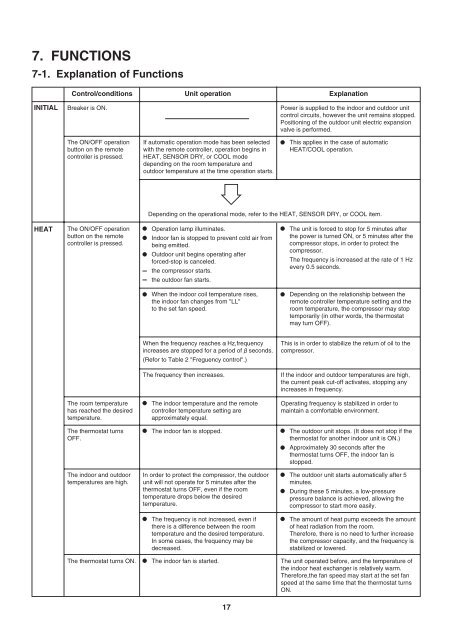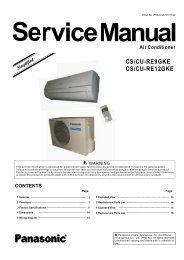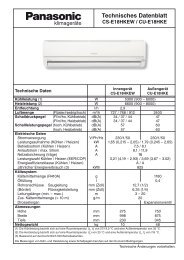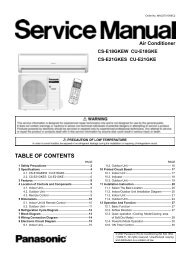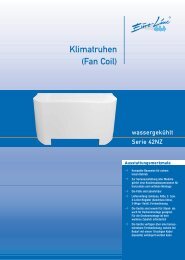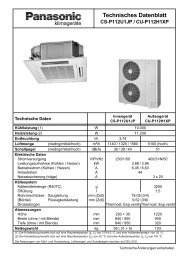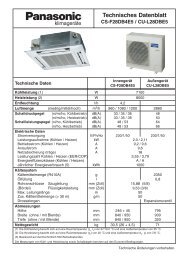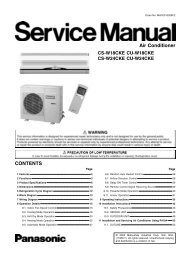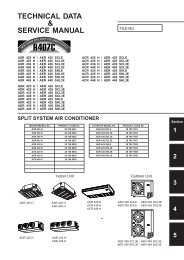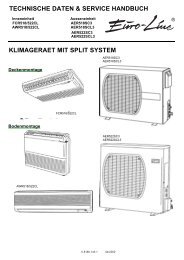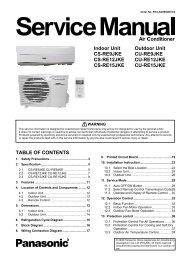technical & service manual dc inverter multi-system air conditioner
technical & service manual dc inverter multi-system air conditioner
technical & service manual dc inverter multi-system air conditioner
You also want an ePaper? Increase the reach of your titles
YUMPU automatically turns print PDFs into web optimized ePapers that Google loves.
7. FUNCTIONS<br />
7-1. Explanation of Functions<br />
Control/conditions<br />
INITIAL Breaker is ON. Power is supplied to the indoor and outdoor unit<br />
control circuits, however the unit remains stopped.<br />
Positioning of the outdoor unit electric expansion<br />
valve is performed.<br />
HEAT<br />
The ON/OFF operation<br />
button on the remote<br />
controller is pressed.<br />
The ON/OFF operation<br />
button on the remote<br />
controller is pressed.<br />
The room temperature<br />
has reached the desired<br />
temperature.<br />
The thermostat turns<br />
OFF.<br />
The indoor and outdoor<br />
temperatures are high.<br />
Unit operation Explanation<br />
If automatic operation mode has been selected<br />
with the remote controller, operation begins in<br />
HEAT, SENSOR DRY, or COOL mode<br />
depending on the room temperature and<br />
outdoor temperature at the time operation starts.<br />
Depending on the operational mode, refer to the HEAT, SENSOR DRY, or COOL item.<br />
Operation lamp illuminates.<br />
Indoor fan is stopped to prevent cold <strong>air</strong> from<br />
being emitted.<br />
Outdoor unit begins operating after<br />
forced-stop is canceled.<br />
the compressor starts.<br />
the outdoor fan starts.<br />
When the indoor coil temperature rises,<br />
the indoor fan changes from "LL"<br />
to the set fan speed.<br />
When the frequency reaches Hz,frequency<br />
increases are stopped for a period of seconds.<br />
(Refor to Table 2 "Freguency control".)<br />
The frequency then increases.<br />
The indoor temperature and the remote<br />
controller temperature setting are<br />
approximately equal.<br />
The indoor fan is stopped.<br />
In order to protect the compressor, the outdoor<br />
unit will not operate for 5 minutes after the<br />
thermostat turns OFF, even if the room<br />
temperature drops below the desired<br />
temperature.<br />
The frequency is not increased, even if<br />
there is a difference between the room<br />
temperature and the desired temperature.<br />
In some cases, the frequency may be<br />
decreased.<br />
17<br />
This applies in the case of automatic<br />
HEAT/COOL operation.<br />
The unit is forced to stop for 5 minutes after<br />
the power is turned ON, or 5 minutes after the<br />
compressor stops, in order to protect the<br />
compressor.<br />
The frequency is increased at the rate of 1 Hz<br />
every 0.5 seconds.<br />
Depending on the relationship between the<br />
remote controller temperature setting and the<br />
room temperature, the compressor may stop<br />
temporarily (in other words, the thermostat<br />
may turn OFF).<br />
This is in order to stabilize the return of oil to the<br />
compressor.<br />
If the indoor and outdoor temperatures are high,<br />
the current peak cut-off activates, stopping any<br />
increases in frequency.<br />
Operating frequency is stabilized in order to<br />
maintain a comfortable environment.<br />
The outdoor unit stops. (It does not stop if the<br />
thermostat for another indoor unit is ON.)<br />
Approximately 30 seconds after the<br />
thermostat turns OFF, the indoor fan is<br />
stopped.<br />
The outdoor unit starts automatically after 5<br />
minutes.<br />
During these 5 minutes, a low-pressure<br />
pressure balance is achieved, allowing the<br />
compressor to start more easily.<br />
The amount of heat pump exceeds the amount<br />
of heat radiation from the room.<br />
Therefore, there is no need to further increase<br />
the compressor capacity, and the frequency is<br />
stabilized or lowered.<br />
The thermostat turns ON. The indoor fan is started.<br />
The unit operated before, and the temperature of<br />
the indoor heat exchanger is relatively warm.<br />
Therefore,the fan speed may start at the set fan<br />
speed at the same time that the thermostat turns<br />
ON.


